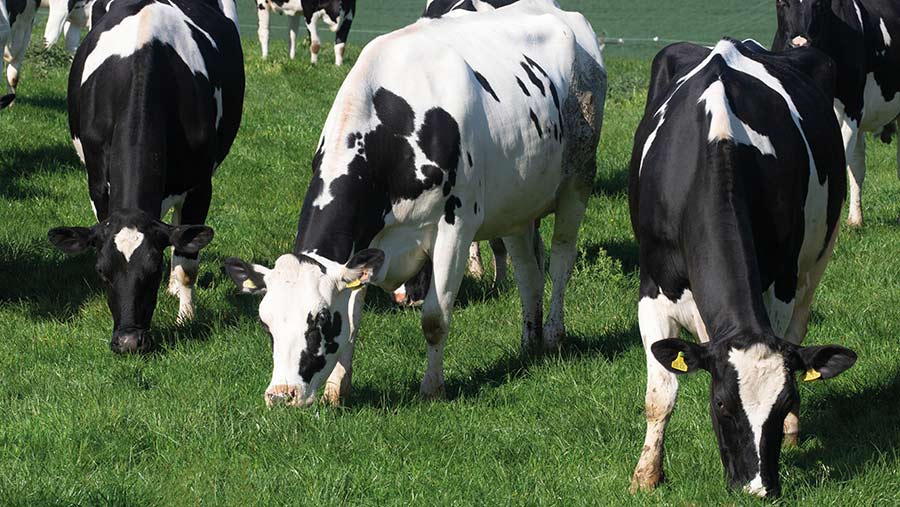Why better dairy performance means a lower carbon footprint
 © Tim Scrivener
© Tim Scrivener The topic of net zero is wide ranging, contentious and shrouded in dogma. It is unfortunate that the concept of decarbonisation has become, in many ways, so politically weaponised.
The pressures to meet net zero must sit within and, at times, be balanced against the wider context of overall environmental sustainability, sustainable farm businesses and food production systems offering food security.
However, the aspiration of net zero does have the potential to stimulate improved resource efficiency and animal welfare on UK farms.
See also: 20 ways dairy producers can tackle net zero
About the author

Miles Middleton originates from a sheep and dairy farm near Askrigg in Upper Wensleydale where his family still farm.
Miles joined Bishopton Veterinary Group in 2012 and became a partner in 2022.
There is significant variation in the carbon footprint of a litre of milk produced across UK dairy farms.
This variation reflects the efficiency with which producers utilise resources. High levels of inefficiency and waste erode farm profitability and increase the carbon footprint.
Unlike most industries, the notion of net zero presents far more complexity for ruminant farming, given the range of different gases and sources of emissions that must be considered.
Ironically, the release of carbon dioxide through burning of fossil fuels and use of electricity represents only a very small element, usually less than 10% contribution towards the overall carbon footprint of milk.
The key gases that drive the carbon footprint of dairy farming are nitrous oxide and methane.
Nitrous oxide
Nitrous oxide typically accounts for 20-35% of the carbon footprint of milk production. It Is released by oxidation of nitrogen compounds.
This happens:
- directly through losses from slurry and fertiliser application
- indirectly as the breakdown products of other environmental pollutants such as ammonia and nitrites
- indirectly through losses from fertiliser application on arable farms producing feed for the livestock sector. These “imported” carbon costs contribute up to 25% of a dairy farm’s carbon footprint, depending on the system.
Methane
Methane accounts for more than half of all emissions on most farms. It is released through the microbial breakdown of plant fibre.
Emissions are primarily driven by enteric fermentation, but also losses from manure storage.
Methods for calculating enteric methane emissions produce slightly differing results, and dietary additives and breeding may offer the potential to curb them.
However, in terms of carbon emissions, methane essentially represents a “fixed cost” of keeping each individual cow.
Systems that produce higher output a cow are at an advantage in this respect, as there are more litres a cow over which to dilute this significant fixed cost.
How to reduce emissions
A strategy to reduce greenhouse gas emissions must focus on three key areas.
Although these are not entirely distinct from each other, they correspond to the major sources of emissions on dairy farms.
1. Biological and feed conversion efficiency of dairy cattle
Data show there is wide variation between farms in the efficiency with which grass and purchased feed are converted to milk.
Poor fertility, infectious disease, mastitis, lameness, metabolic disease and breeding all affect feed conversion efficiency.
Irrespective of the production system, cattle that are underperforming and failing to meet their production potential represent not just a missed financial opportunity to the farm but, through ongoing methane emissions, a significant carbon cost, too.
2. Nitrogen efficiency
In a hypothetical 100% nitrogen-efficient system, the only nitrogen leaving the farm would be in the form of meat and milk.
These “losses” could be readily replaced through nitrogen fixation from the air.
In reality, massive quantities of nitrogen are lost from dairy farms into the air in the form of ammonia and nitrous oxide, and through nitrates polluting groundwater.
This nitrogen is replaced with bought-in fertiliser, which carries with it a significant carbon cost from its manufacture, and an escalating financial cost.
Dairy farmers invariably possess an abundance of slurry, which is often not seen as the valuable resource that it is.
It requires about 950cu m of natural gas to produce 1t of ammonium nitrate; if gas supplies tighten, the current inefficiencies of using nitrogen on farm cannot be tolerated or justified by the industry.
Overfeeding of protein in dairy rations results in less efficient use of dietary protein, increased excretions and more emissions from slurry.
In addition, protein supplementation, specifically soya bean meal, carries a significant indirect land use change carbon cost.
3. Carbon cycling and soil respiration
Rather than an inert substrate into which carbon can be loaded, healthy soil represents a diverse ecosystem of synergistic relationships between plants and microbes.
In turn, these feed nematodes, invertebrates, small birds and, ultimately, apex predators.
Overall, healthy soils tend to contain more carbon, and depleted soils tend to be depleted of carbon. But the picture is far more nuanced than simply looking at soil organic carbon.
In simplistic terms, it is the “turnover” of carbon as it moves through ecosystems that sustains all life in soils.
Obviously agricultural land does not represent natural ecosystems and much of it is currently devoid of significant biodiversity.
But these soils are still ecosystems which can be enhanced and that ultimately support human civilisation.
Beyond net zero
There are significant opportunities for dairy farming to improve its carbon footprint, leading to improved efficiency and improved returns, while reducing environmental impact.
However, it is unclear whether using net zero as the only metric to measure the environmental sustainability of agriculture is the correct path.
Other factors such as biodiversity and maintaining rural communities need to be considered to meet the wider environmental goals of building healthy soils and a sustainable food production system.
